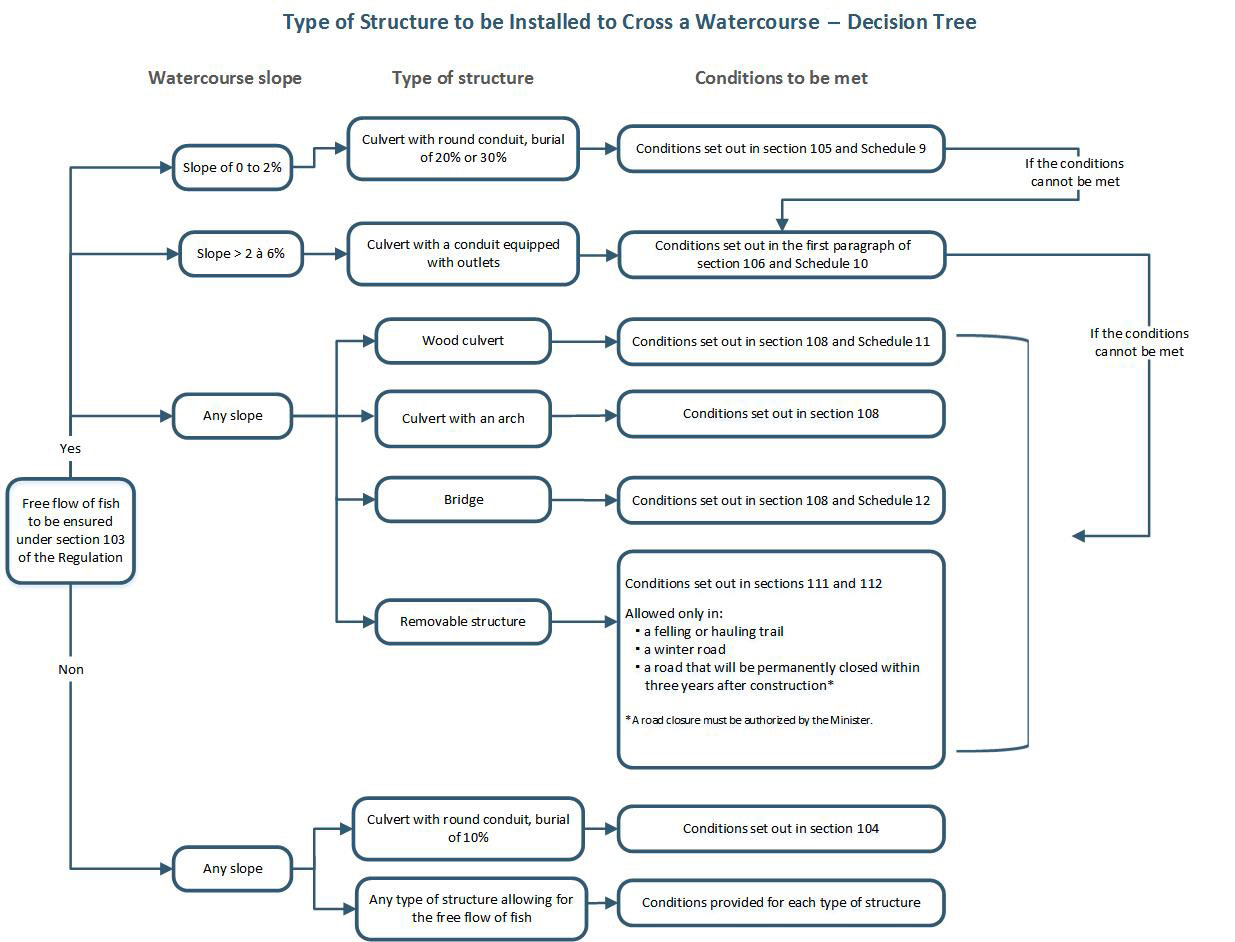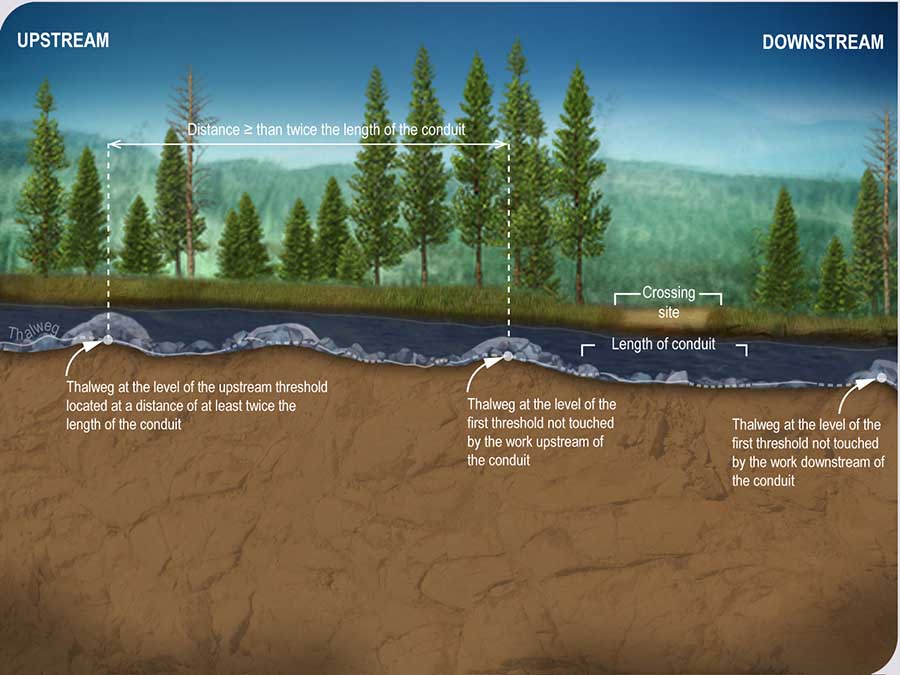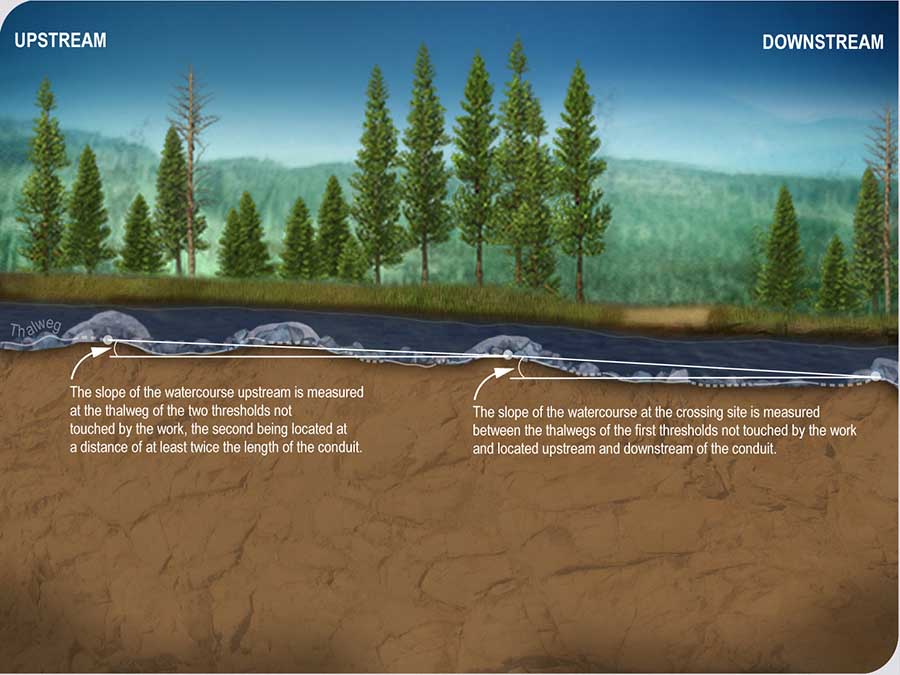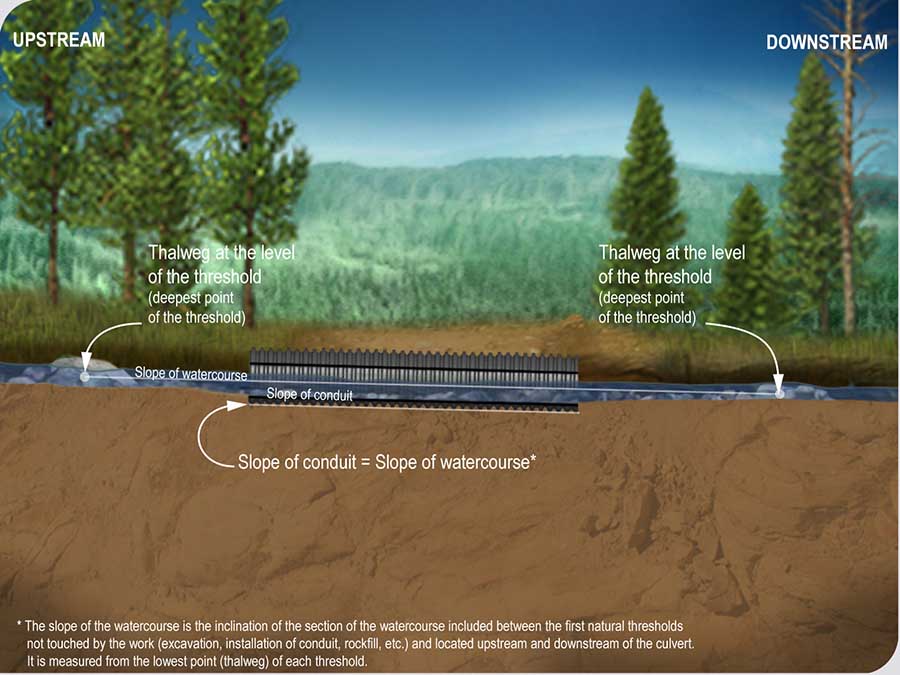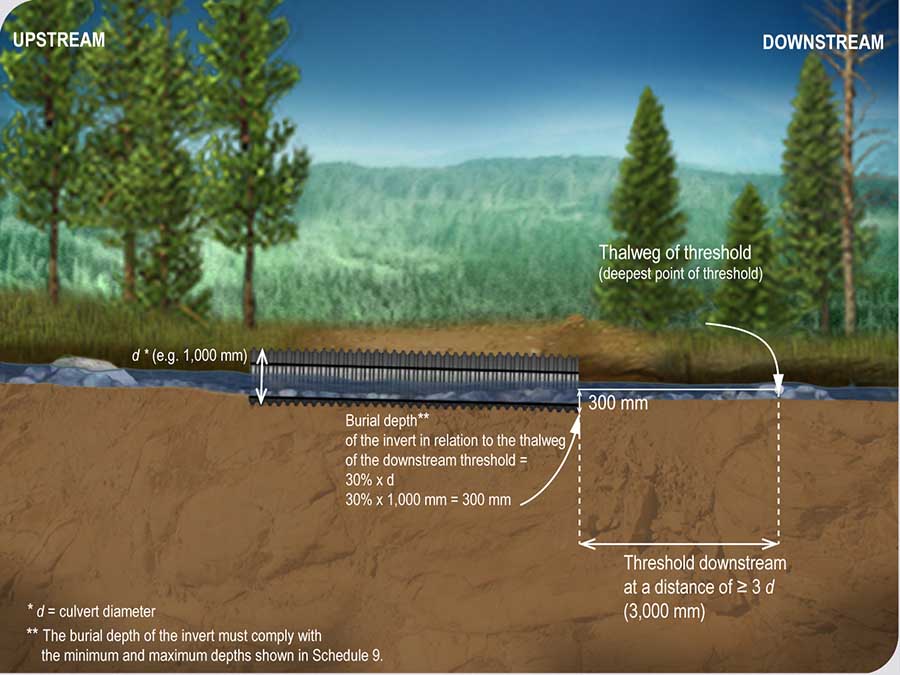Schedule 9
Conditions to meet for a culvert with a round conduit where free flow of fish must be ensured
![]()
1
Explanations
All the conditions (width, slope, burial, narrowing, etc.) indicated in Schedule 9 must be complied with when installing a culvert with a circular conduit in a watercourse where the free circulation of fish must be ensured. If it is not possible to comply with a given condition (e.g. if it is difficult to comply with burial conditions due to the presence of rock), another type of structure (arch, bridge, etc.) must be installed instead.
Additional information
The decision tree below can be used to decide on the type of structure that must be installed to cross a watercourse.
1 The slope is the inclination of the section of the watercourse included between the first natural thresholds not touched by the work (excavation, installation of conduit, rockfill, etc.) and located upstream and downstream of the culvert. It is measured from the thalweg of each threshold. ![]()
2
Additional information
The slope of a watercourse is measured between two natural thresholds unaffected by the work (excavation, conduit installation, riprap, etc.). A threshold is an elevation of substrate across a watercourse that is not necessarily perpendicular to its axis and that is situated between the two deepest sections.
In a watercourse with a standard profile (no thresholds, channels or rapids), the slope may be measured from arbitrary points on the watercourse thalweg.
The slope of a watercourse must be assessed using a device that is sufficiently accurate. For example, a preliminary estimate may be made using a clinometer, but more accurate instruments, such as a precision sight level or an integrated set of measuring instruments that automatically measure both angles and distances during a land survey, are needed at the culvert installation stage.
The preliminary estimate of the slope of the watercourse when marking the course could help guide the initial selection of the type of structure suitable for the watercourse to be crossed. Some watercourse characteristics (clay bottom, dead water, pronounced meanders, etc.) may also be additional indications of a slope that is potentially inferior to 2%.
However, before the final choice of the structure type, the slope of the watercourse must be validated with accurate instruments. For a circular conduit, the validation must demonstrate that the measured slope does not actually exceed 0.5%, 1% or 2%, depending on the length of the circular conduit. If the validation is inconclusive, the choice of the original intended circular conduit should be modified for a structure adapted to the watercourse to ensure the free flow of fish (conduit with outlets, wood culverts, culverts with arches, bridges, etc.). Some situations increase the uncertainty associated with the use of a slope estimate at the preliminary stages of the project and therefore the risk of having to change the type of structure at the end of the project. These situations must be considered by the proponent as, regardless of the method used, he or she remains responsible for compliance with all of the Regulation’s conditions.
Figure Schedule 9A Placement of thresholds used to measure the slope of a watercourse
Figure Schedule 9B Measuring the slope of a watercourse
2 The depth of the burial to the invert downstream is measured with relation to the thalweg of the threshold of the natural bed of the watercourse, located at a distance of over three times the diameter ![]()
3 Except 600 mm diameter conduits that must be buried at a depth of 180 mm.
3
Additional information
The elevation of the thalweg as well as the slopes of the watercourse and the circular conduit must be measured with accurate instruments (precision sight level, an integrated set of measuring instruments that automatically measure both angles and distances during a land survey, etc.).
Figure Schedule 9C Burial of a conduit following the slope of the watercourse
Figure Schedule 9D Burial depth for a conduit
4 The width of the watercourse is measured at the level of the upper limit of the banks. ![]()
4
Additional information
How is the width of a watercourse measured?
The width of a watercourse is calculated using the average of at least four representative measurements of the natural watercourse taken upstream and downstream of the crossing site. If there are signs of narrowing or widening, the section in question (e.g. area disturbed by a beaver dam) must be excluded. The width is measured at the level of the upper limit of the banks. The method used to identify the upper limit is shown in the definition of “bank”.
bank
The distance between the conduits of a culvert with parallel conduits must be considered when calculating the narrowing of the natural width of the watercourse by the culvert. The minimum distance between the conduits is one metre, as specified in section 102 of this Regulation.
5 Corresponds to the slope of a watercourse measured between two natural thresholds that are not touched by the work and are located upstream at a distance equivalent to twice the length of the conduit.![]()
5
Additional information
Assessment of the slope of the watercourse upstream of the work is not required or even useful if the conduit is sized to cause a maximum narrowing of 20% of the width of the watercourse. Further narrowing is only possible if the length of the conduit does not exceed 12 m and is installed on a watercourse with an upstream slope of no more than 1%. The preliminary estimate of the slope of the watercourse when marking the course could assist in orienting the initial conduit sizing, by confirming or more surely denying this possibility.
However, before the final sizing of the conduit, the slope of the watercourse upstream of the work must be validated with accurate instruments. The validation must demonstrate that the measured slope does not actually exceed 1%. If the validation is inconclusive, the size of the conduit originally planned should be increased to meet the requirements of Schedule 9. Some situations increase the uncertainty associated with the use of a slope estimate at the preliminary stages of the project and therefore the risk of having to modify the design of the structure at the end of the project. These situations must be considered by the proponent as, regardless of the method used, he or she remains responsible for compliance with all of the Regulation’s conditions.
Given these reservations, it will often be advantageous to provide a conduit with a diameter equal to the width of the watercourse. The actual narrowing of the watercourse at the top of the banks depends on a number of factors, including the shape of the circular conduit (minimum at the centre level) and the degree of burial. The conduit sizing must take into account the combination of all factors that influence narrowing. The selection of a circular conduit diameter equivalent to the width of the watercourse simplifies the design and reduces the acquisition of preliminary data, as this approach ensures a maximum narrowing of 20% for all possible combinations, regardless of the degree of burial required (20%, 30%), the length of the conduit, or the slope of the river upstream.

